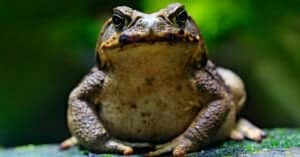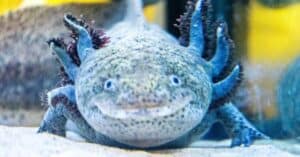The 10 Largest Frogs In The World
Amphibians are cold-blooded animals that can live both in the water and on land, and when we think of amphibians, frogs and toads instantly jump to mind. Usually, we would think of frogs as being quite small (especially baby frogs!) – we certainly wouldn’t expect there to be a frog that is bigger than a pet cat, or one with a mouth so wide it can swallow other frogs whole. In fact, there are a lot of giants in the frog world, with one species that can weigh more than 7 pounds! Here are the largest frogs in the world ranked by their length.
#10: Giant River Frog

Found in Borneo, Indonesia, and Malaysia, the giant river frog can grow to a snout to vent length of 17cm (6.7 inches). With a mainly light brown appearance, these are found along the banks of streams in the rainforests where they easily blend in with their surroundings. Although they are often hunted locally for food, and their habitat is affected by deforestation, there is still a healthy population of giant river frogs and their conservation status is Least Concern.
#9: Smoky Jungle Frog
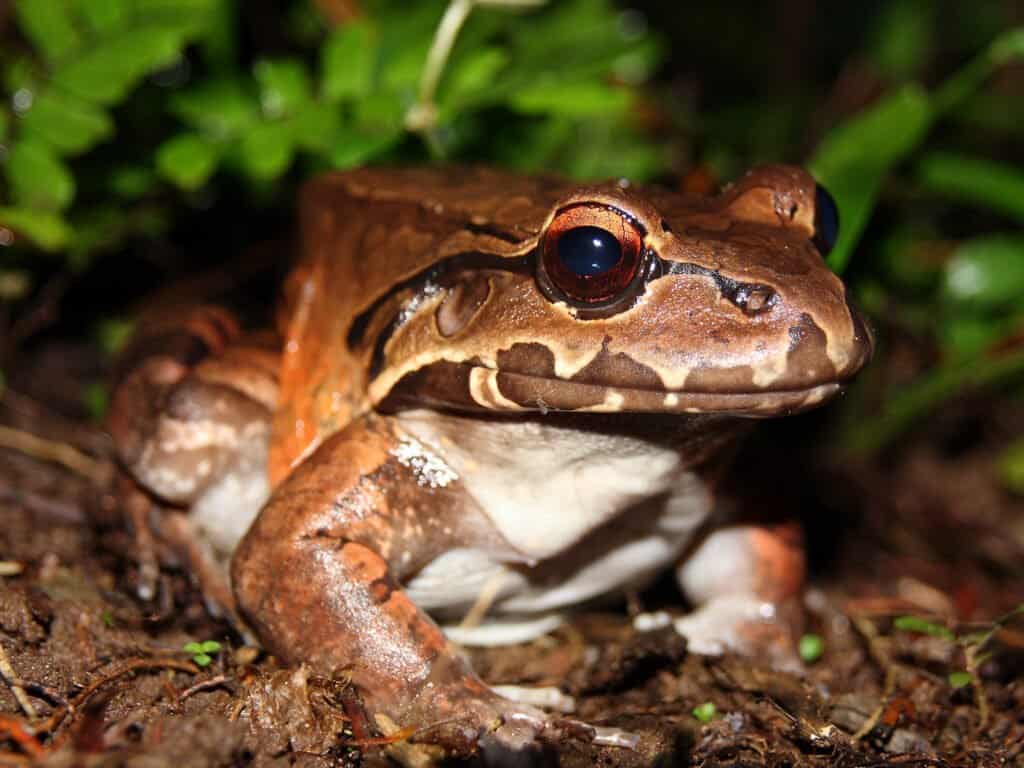
Ryan M. Bolton/Shutterstock.com
Female smoky jungle frogs grow to around 19 centimetres with males being slightly smaller and they have a large head with a rounded snout and a tan body with red-brown markings. Preferring the tropical and subtropical forests and swamps, these frogs are widespread throughout Bolivia, Brazil, Ecuador, Colombia, and Peru. They eat a wide range of things, including spiders, lizards, snakes, bats, birds, and even other frogs. Perhaps one of the most interesting things about the smoky jungle frog is their ability to evade capture and their defence mechanism. They can jump great distances very fast and if they are caught they let out a very high-pitched scream that usually makes the predator release them. Not only, that but their skin contains a very strong toxin – leptodactylin – that they can release when they are attacked. Even someone stood nearby would end up sneezing and have a runny nose and swollen eyes. Therefore, it should come as no surprise that their conservation status is Least Concern.
#8: Surinam Horned Frog

The Surinam horned frog is also known as the Amazonian horned frog and can grow to a length of around 20cm (7.9 inches) and weighs in at 0.5kg (1.1 lbs). It is easily identified by its extremely wide mouth and the “horns” above its eyes. Found in several countries, including Brazil, Bolivia, Colombia, Ecuador, Suriname, Peru, and Venezuela, the Surinam horned frog is green and brown so that it can blend in with its surroundings. This is particularly useful as it often spends hours sitting and waiting for the chance to attack its prey. Considering the size of their mouths, it’s unsurprising that they eat pretty much anything, including lizards, birds, small mammals, and other frogs – often just swallowing their prey whole. These frogs are not under threat and they are classified as being a species of least concern.
#7: American Bullfrog

American bullfrogs are found widely across the US and they have also been introduced into many other countries in Europe and Asia. Females are slightly bigger than males and can grow to 20cm (7.9 inches) in length and weigh just over 0.5kg (1.1 lbs). It is classed as an invasive species in many countries as it eats fish, snakes, small turtles, birds, and other small mammals and is thought to be threatening the survival of some of the species that it eats. They prefer to live in swamps, ponds, and lakes and are often a brown or olive green color. Their conservation status is Least Concern.
#6: Mountain Chicken Frog

A relative of the smoky mountain frog, the mountain chicken frog is found mainly in Dominica and Montserrat. They grow to around 20 cm (7.9 inches) long and can weigh up to 1kg (2.2 lbs). They have yellow bellies and their bodies are usually a brown color with spots or stripes on them which provide them with camouflage on the banks of the streams where they are often found. The mountain chicken frog has often been hunted for food, which, combined with a fungal disease that has swept through the population, has resulted in them being officially classed as critically endangered as there are less than 100 left in the wild.
#5: African Bullfrog
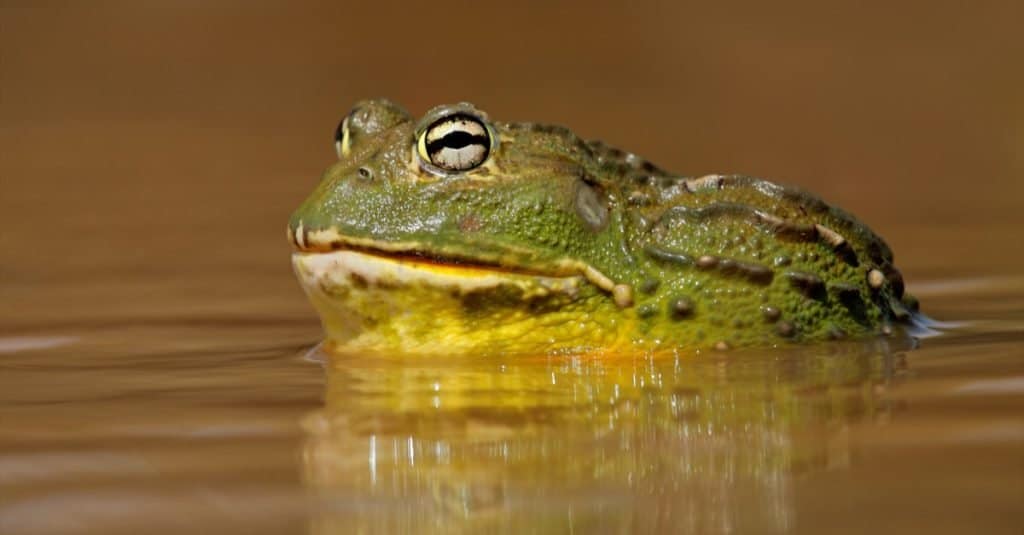
EcoPrint/Shutterstock.com
The African bullfrog is also known as the pixie frog and can grow to the impressive size of 25cm (9.8 inches). They are olive green and have either a yellow or an orange throat and they are usually found in the deserts or floodplains of Africa. Despite preferring to live near to water, African bullfrogs can easily survive in places that are completely dry as they simply dig a hole in the ground when it becomes too hot and dry for them on the surface. They are excellent hunters and usually lay in wait for their prey before pouncing and swallowing them whole.
Their conservation status is Least Concern and more information can be found on them here.
#4: Blyth’s River Frog
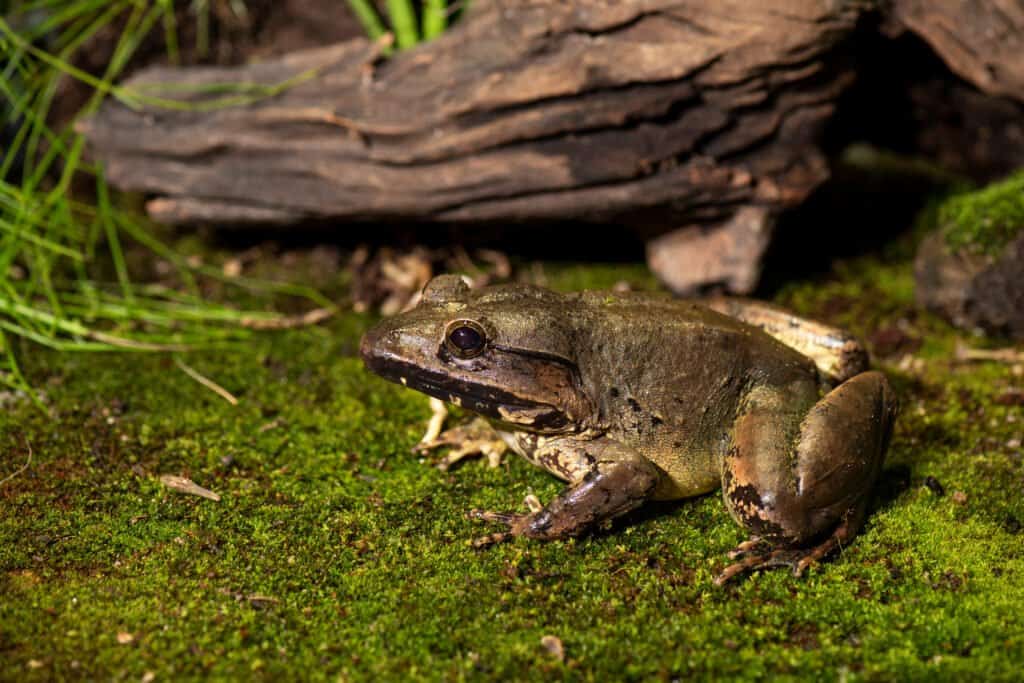
With females reaching lengths of up to 26cm (10.2 inches) and weighing in at around 1kg (2.2 lbs), the Blyth’s river frog, also known as the Giant Asian river frog, is the biggest frog in Asia. These large frogs are usually brown, yellow, or grey, and are found around rocky streams in the forest regions of Indonesia, Malaysia, Thailand, and Singapore. They are a popular source of food for local people and from the hunting and the effects of logging and deforestation which is destroying their habitat, the Blyth’s river frog is now classed as being Near Threatened.
#3: Lake Junin Frog
As the name suggests, these huge frogs that can grow up to 30 centimeters (11.8 inches) long are frequently found in Lake Junin in Peru, but they are also now found in other lakes in the area and in parts of the Mantaro River. Weighing an impressive 2kg (4.4 lbs), the Lake Junin frogs rarely ever leave the water at all, preferring to live, eat, and breed in it. They are dark brown and have completely smooth skin, which is why they are sometimes also known as the Andes smooth frog. Unfortunately, these aquatic frogs are under serious threat from hunting and the pollution of the lakes they live in, meaning that their conservation status is now officially endangered.
#2: Chilean Giant Frog
Although they are also known as the helmeted water toad, the Chilean giant frog is not actually a toad and is from the family group Calyptocephalellidae. Females are much larger than males and can grow to a snout to vent length of 32cm (12.6 inches) while weighing 3kg (6.6 lbs). By comparison, the males only grow to around 15cm, but even tadpoles can be around 10cm in length. As the name suggests, they are from Chile and are mainly found in the lowlands in deep ponds. Their color can vary between yellow, green, and brown and they have a large, round head. Due to their large size, they have often been hunted for food or farmed specifically for their meat, and although it is now illegal to hunt them, there is still a roaring trade for them on the black market and their numbers have declined so much that their conservation status is now classed as Vulnerable.
#1: Goliath Frog

Coming in at the number one spot with a snout to vent length of 32cm (12.6 inches) and weighing an impressive 3.3kg (7.3 lbs) is the Goliath frog. This makes the goliath frog the largest frog in the world! The species is found in streams and the rainforests of Cameroon and Equatorial Guinea. They are so big that the males can easily move rocks to create huge nests up to three feet wide for the female to lay her eggs in. Their color is usually either yellow-green or yellow-orange and they eat a variety of fish, snakes, birds, small mammals, and other amphibians such as newts and salamanders. However, the tadpoles only eat one plant – podostemaceae. These giants have long been hunted for food and caught for the pet trade, and as their habitat is also under great threat from deforestation, they are officially an endangered species.
You can read more about the goliath frogs here.
More from A-Z Animals
Amphibians are cold-blooded animals that can live both in the water and on land, and when we think of amphibians, frogs and toads instantly jump to mind. Usually, we would think of frogs as being quite small (especially baby frogs!) – we certainly wouldn’t expect there to be a frog that is bigger than a pet cat, or one with a mouth so wide it can swallow other frogs whole. In fact, there are a lot of giants in the frog world, with one species that can weigh more than 7 pounds! Here are the largest frogs in the world ranked by their length.
#10: Giant River Frog

Found in Borneo, Indonesia, and Malaysia, the giant river frog can grow to a snout to vent length of 17cm (6.7 inches). With a mainly light brown appearance, these are found along the banks of streams in the rainforests where they easily blend in with their surroundings. Although they are often hunted locally for food, and their habitat is affected by deforestation, there is still a healthy population of giant river frogs and their conservation status is Least Concern.
#9: Smoky Jungle Frog

Ryan M. Bolton/Shutterstock.com
Female smoky jungle frogs grow to around 19 centimetres with males being slightly smaller and they have a large head with a rounded snout and a tan body with red-brown markings. Preferring the tropical and subtropical forests and swamps, these frogs are widespread throughout Bolivia, Brazil, Ecuador, Colombia, and Peru. They eat a wide range of things, including spiders, lizards, snakes, bats, birds, and even other frogs. Perhaps one of the most interesting things about the smoky jungle frog is their ability to evade capture and their defence mechanism. They can jump great distances very fast and if they are caught they let out a very high-pitched scream that usually makes the predator release them. Not only, that but their skin contains a very strong toxin – leptodactylin – that they can release when they are attacked. Even someone stood nearby would end up sneezing and have a runny nose and swollen eyes. Therefore, it should come as no surprise that their conservation status is Least Concern.
#8: Surinam Horned Frog

The Surinam horned frog is also known as the Amazonian horned frog and can grow to a length of around 20cm (7.9 inches) and weighs in at 0.5kg (1.1 lbs). It is easily identified by its extremely wide mouth and the “horns” above its eyes. Found in several countries, including Brazil, Bolivia, Colombia, Ecuador, Suriname, Peru, and Venezuela, the Surinam horned frog is green and brown so that it can blend in with its surroundings. This is particularly useful as it often spends hours sitting and waiting for the chance to attack its prey. Considering the size of their mouths, it’s unsurprising that they eat pretty much anything, including lizards, birds, small mammals, and other frogs – often just swallowing their prey whole. These frogs are not under threat and they are classified as being a species of least concern.
#7: American Bullfrog

American bullfrogs are found widely across the US and they have also been introduced into many other countries in Europe and Asia. Females are slightly bigger than males and can grow to 20cm (7.9 inches) in length and weigh just over 0.5kg (1.1 lbs). It is classed as an invasive species in many countries as it eats fish, snakes, small turtles, birds, and other small mammals and is thought to be threatening the survival of some of the species that it eats. They prefer to live in swamps, ponds, and lakes and are often a brown or olive green color. Their conservation status is Least Concern.
#6: Mountain Chicken Frog

A relative of the smoky mountain frog, the mountain chicken frog is found mainly in Dominica and Montserrat. They grow to around 20 cm (7.9 inches) long and can weigh up to 1kg (2.2 lbs). They have yellow bellies and their bodies are usually a brown color with spots or stripes on them which provide them with camouflage on the banks of the streams where they are often found. The mountain chicken frog has often been hunted for food, which, combined with a fungal disease that has swept through the population, has resulted in them being officially classed as critically endangered as there are less than 100 left in the wild.
#5: African Bullfrog

EcoPrint/Shutterstock.com
The African bullfrog is also known as the pixie frog and can grow to the impressive size of 25cm (9.8 inches). They are olive green and have either a yellow or an orange throat and they are usually found in the deserts or floodplains of Africa. Despite preferring to live near to water, African bullfrogs can easily survive in places that are completely dry as they simply dig a hole in the ground when it becomes too hot and dry for them on the surface. They are excellent hunters and usually lay in wait for their prey before pouncing and swallowing them whole.
Their conservation status is Least Concern and more information can be found on them here.
#4: Blyth’s River Frog

With females reaching lengths of up to 26cm (10.2 inches) and weighing in at around 1kg (2.2 lbs), the Blyth’s river frog, also known as the Giant Asian river frog, is the biggest frog in Asia. These large frogs are usually brown, yellow, or grey, and are found around rocky streams in the forest regions of Indonesia, Malaysia, Thailand, and Singapore. They are a popular source of food for local people and from the hunting and the effects of logging and deforestation which is destroying their habitat, the Blyth’s river frog is now classed as being Near Threatened.
#3: Lake Junin Frog
As the name suggests, these huge frogs that can grow up to 30 centimeters (11.8 inches) long are frequently found in Lake Junin in Peru, but they are also now found in other lakes in the area and in parts of the Mantaro River. Weighing an impressive 2kg (4.4 lbs), the Lake Junin frogs rarely ever leave the water at all, preferring to live, eat, and breed in it. They are dark brown and have completely smooth skin, which is why they are sometimes also known as the Andes smooth frog. Unfortunately, these aquatic frogs are under serious threat from hunting and the pollution of the lakes they live in, meaning that their conservation status is now officially endangered.
#2: Chilean Giant Frog
Although they are also known as the helmeted water toad, the Chilean giant frog is not actually a toad and is from the family group Calyptocephalellidae. Females are much larger than males and can grow to a snout to vent length of 32cm (12.6 inches) while weighing 3kg (6.6 lbs). By comparison, the males only grow to around 15cm, but even tadpoles can be around 10cm in length. As the name suggests, they are from Chile and are mainly found in the lowlands in deep ponds. Their color can vary between yellow, green, and brown and they have a large, round head. Due to their large size, they have often been hunted for food or farmed specifically for their meat, and although it is now illegal to hunt them, there is still a roaring trade for them on the black market and their numbers have declined so much that their conservation status is now classed as Vulnerable.
#1: Goliath Frog

Coming in at the number one spot with a snout to vent length of 32cm (12.6 inches) and weighing an impressive 3.3kg (7.3 lbs) is the Goliath frog. This makes the goliath frog the largest frog in the world! The species is found in streams and the rainforests of Cameroon and Equatorial Guinea. They are so big that the males can easily move rocks to create huge nests up to three feet wide for the female to lay her eggs in. Their color is usually either yellow-green or yellow-orange and they eat a variety of fish, snakes, birds, small mammals, and other amphibians such as newts and salamanders. However, the tadpoles only eat one plant – podostemaceae. These giants have long been hunted for food and caught for the pet trade, and as their habitat is also under great threat from deforestation, they are officially an endangered species.
You can read more about the goliath frogs here.

